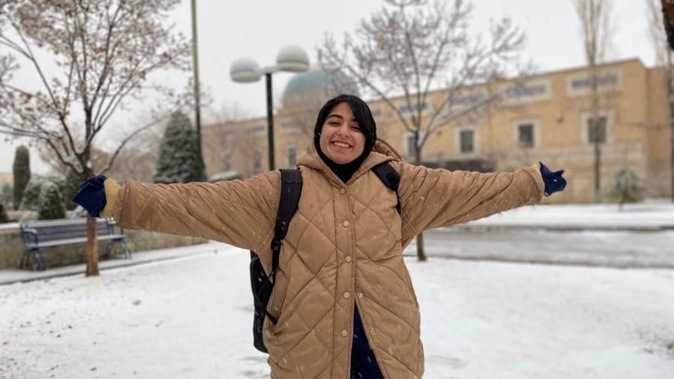
She dreamed of seeing the band Coldplay live in concert. She loved trying new foods and was learning Italian.
She wrote poetry constantly and shared it with friends and family.
She was so proud of having summited Iran’s highest peak, Mt Damavand, that she made sure to mention that fact to everyone she met.
She was, as her friends described in phone interviews and text messages this week, as bright and full of life as the sunflowers that she adored.
On Friday as they slept, Parnia Abbasi and her family were killed by an Israeli strike on their apartment building in the Sattarkhan neighbourhood of Tehran.
They were among the first civilian deaths in a sustained assault that does not yet show signs of stopping.
Israel appeared to have been targeting a professor at Shahid Beheshti University, Iranian media reported.
Pictures of the Abbasis’ building shared online appeared to match those of Abdolhamid Minouchehr, head of the nuclear engineering faculty at the university.
The Israel Defence Forces declined to comment on Abbasi’s death but confirmed in a statement that the military had targeted and “eliminated” Minouchehr, whom it described as an expert on reactor physics.
“The IDF targets military objects only and acts to prevent civilian casualties,” a spokesperson said.
The latest figures available, provided on Monday NZT by an Iranian Health Ministry official, showed that 224 people had been killed by Israeli strikes in Iran.
It was unclear what proportion were civilians.
In Israel, the Prime Minister’s office reported that 24 people had been killed by Iranian missile barrages.
Iranian media published a photo of the rubble of a destroyed building, under which a woman’s hair rested on a pink, bloodstained pillowcase.
A friend who gave her name as Maryam told Iran’s Hammihan newspaper that the picture was of Abbasi. Abbasi’s extended family members did not respond to interview requests.
This week, Abbasi’s friends shared described in interviews, messages and on social media their favourite memories of her: how she took them camping outdoors for the first time; how she freely gave them gifts; how her sense of humour often took a moment to sink in and then bowled them over with laughter.
She did silly dances for the camera. Her 24th birthday was in just a few days.
As her friends struggled to come to terms with losing her in such a sudden and violent way, they also faced an unexpected source of anguish.
Some of their fellow Iranians were convinced that Abbasi must have had some connection to Iran’s security forces, or else she would not have been killed.
Some speculated that she was the daughter of Fereydoon Abbasi, a top Iranian nuclear scientist who was also killed in the Israeli strikes. (Her friends shared documents that showed her full last name – Abbasi-Arimi – was different from the scientist’s.)
Others claimed she had written a poem in honour of Qasem Soleimani, the general in Iran’s Islamic Revolutionary Guard Corps who was killed in a United States airstrike in 2020. (The Persian-language fact-checking website Factnameh said that was false.)
“They don’t want to accept that when war happens, it’s not just military people, it’s not just the regular army or the Revolutionary Guard who are casualties of this war,” said Arvin Abedi, one of her friends. “Ordinary people can easily be destroyed.”
In the comments on social media posts about Abbasi’s death, Iranians attacked each other for what they saw as views that were either pro-Israel or favouring Iran’s Government.
But as her death became fodder for the bitter debates that now often roil Iranian society, Abbasi’s friends said they did not want the fullness of her life to be lost.
“She has the right to not be forgotten,” Abedi said.
Her father, Parviz, was a retired Education Ministry employee, two friends said, and her mother, Masoumeh, was a retired bank employee who cared for her children’s friends as if they were her own.
Abbasi’s little brother, Parham, was sweet and talkative. Parviz Abbasi visited his ailing mother on a weekly basis in the northern village of Arim and would bring back endless boxes of oranges that he had picked himself, Abedi said.
Abbasi’s parents saved money for years to afford a bigger apartment, where each of their children would have their own bedroom. They had moved into their new place just a few months ago, her friends said.
One of her favourite poets was Nader Naderpour, a leader of Iran’s New Poetry movement, one of her friends said in a text message seen by the Washington Post.
She shared her poems with her mother and friends, carefully gauging their reactions as they read her verses, she said once, according to an Instagram post by Vazn-e Donya, a magazine that published her work in the past.
“I look at everything that happens in my life in a way that allows me to write about it, and to express what I felt in that moment through poetry,” she said, according to the post.
“In a thousand places/ I come to an end/ I burn,” read one of her poems, which had been published by the magazine.
“I become a faded star/ that turns to smoke/ in your sky.”
Take your Radio, Podcasts and Music with you









